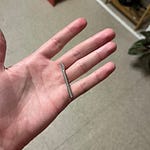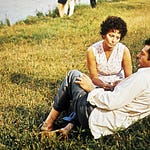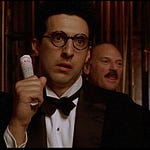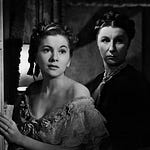Read Part 1.
Any Twitter follower of Gretchen Felker-Martin1 knows that Art, with a capital A, is one of her favorite subjects. Hers is no idle interest. A trans woman writer and critic who explores and critiques the ins, outs, and limits of horror, gore, and deviance, Gretchen has become a lightning-rod for the ire of “think-of-the-children”-type censors of creativity and imagination. She’s tweeted and written at length about what she calls the “almost theme park guest mentality” of artistic consumers who feel entitled to “seamless and uniformly pleasurable experience from any art they purchase.” These are the people who feel victimized when they encounter art they do not like or understand, or find to be troubling, objectionable, abusive, or triggering—and who, for these reasons, wish to not only control that art’s availability, but remove it from the category of Art altogether (which matters to working artists like Gretchen because that which is designated Art—like that which is designated Human, Normal, Healthy, and Beautiful—enjoys certain legal and commercial protections).
Gretchen’s searing lucidity on this point is informed by personal experience and a knowledge of what happens to artists (as well as to humans) that don’t have these protections. Whether or not her trolls know it, they’re participating in a long and bloody history of efforts to delimit and control expressions of art, obscenity, and pornography, imbuing status on the former while censuring the latter two, moving the goalposts at warp-speed to suit their agendas. What is new, however, are the attacks on certain kinds of Art that employ a novel variation on that old “think-of-the-children” chestnut: the requirement of fulfilling a specific definition of “consent” for that Art to be not only “valid,” but safe, acceptable, and legal. Regarding this trigger-warning warring2, Gretchen has remained consistent on a position with which I totally agree: Consent, she says, is the wrong framework for experiencing art.
As I quoted John Berger last week, “Valid art, in fact, because it derives from passionate, fairly simple convictions about life, is bound, in one sense, to be intolerant.” And to some, so it goes, intolerable. The pleasure and power of art is in its ability to inspire uncontrolled emotional responses, which no one, not even the artist themself, can predict. As someone who has been triggered by art in their time, I think this is great! Magnificent! My own triggering is, and I mean this in the least cynical and bitchy sense I can muster, a personal problem. To see it as otherwise is to conflate the creation of art with the perpetration of harm, and unless someone’s got me tied up with my eyes stretched open, droog-style, how can this comparison ever honestly be made?
(Well, actually, there are plenty of examples that stress-test my framing of this situation—like the racist and anti-indigenous Sam Durant sculpture, Scaffold, recently revisited in Maggie Nelson’s new book3—but we can’t have these conversations without also talking about power: of the artist and of the institutions that support them, of the communities in which the art is displayed, of the institutional and monetary value of the object d’art itself. This is especially the case if the solution to artistic “harm,” as many have pointed out before me, always seems to return to the same solutions: policing, incarceration, the engorgement of the state.)
While I wish no one distress, the “good/safe” vs. “bad/triggering” framing of art flattens the entire field, erasing affective responses from sublime euphoria all the way down to meh. Because, like, negative reactions to art are good! They allow you to learn what you like and don’t like, giving you a deeper appreciation of your own pleasures and disgusts, and a context for having the ability to assess art at all. What is Art without judgment? And what is Art, too, without the ability to contextualize it, to ascertain a knowledge of your own limits?
Just the other day, as I was literally laughing my way through My Lunches with Orson—Henry Jaglom’s collection of late-in-life interviews with the big man—on the E train, I was especially riveted by the chapter in which the two friends discussed Art and one’s taste for it. “I don’t believe, in literature, that anybody can have a taste so catholic that he genuinely likes Joyce and Eliot—and Céline,” says Orson over his plate of chicken salad and capers. “I think [Francis] Bacon is a great painter, but I hate his paintings…I believe that there is no law, and should be no law under the heavens that tells an artist what he ought to be.” (Speaking of Bacon, remember Berger's big Bacon about-face? So epic. Will plug every chance I get.)
To be sure, Welles, the great and prevaricating raconteur, goes on to contradict himself only a few moments later, but my point here is that these endless debates about what is and isn’t Art (debate being a nice way of describing the pile-ons and cancellation crusades conducted mostly online and mostly on people already marginalized by their identity) steal our attention from more pressing questions, like asking what art is or does. Of course, distraction is the point (though Gretchen does her best to keep us on topic. Subscribe to her Patreon!). Attempting to universalize the experience of Art along the lines of what is already conventionally understood as good, safe, normal, and moral in a literal white-supremacist patriarchy harms marginalized artists and also gets in the way of doing something about art that is actually harmful.
God, this series is expanding like proving dough. I have all these notes—Toni Morrison on art as disruption of social oppression, which “functions like a coma on the population”; Leo Tolstoy on art’s business as making “that understood and felt which, in the form of an argument, might be incomprehensible and inaccessible.” But we’ll have to get into that next week.
David tweets at @k8bushofficial. Read the earthquake room. Keep reading DAVID to find out when their second novel, X (Catapult, 2022), is available for preorder.
Subscribe to support GOOD ADVICE/BAD GAY, an advice series from an anonymous gay therapist who’s not afraid to hurt your feelings with the truth. (Sample an unlocked post for a taste of what you’re missing.) 100% of funds go to support a rotating selection of mutual aid and reparations projects.
Want advice? Email badgayadvice@gmail.com with your questions for a free 3-month subscription.
Her first book, Manhunt, for which I wrote a teensy little review last year, is out soon. Preorder it! You won’t regret it!
Old DAVID readers will notice that while I once used TWs, I no longer do. This isn’t me taking a stand, but rather the result of an evolution in my approach to accessibility here on this newsletter. I do occasionally use them on my Instagram if I’m posting pictures of my own body being harmed and want to give people a heads-up that I’m interrupting the regularly scheduled programming of memes and fundraisers, although I won’t be hectored about what I post on my own account (unless it’s by the platform itself, in which case my hands are tied). I enjoy bloodplay and have never hidden that.
If you have the chance to read them, you’ll find that Charlotte Shane’s and Andrea Long Chu’s reviews of this book were both excellent.












